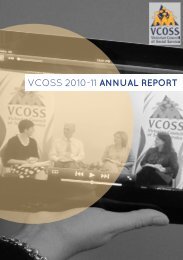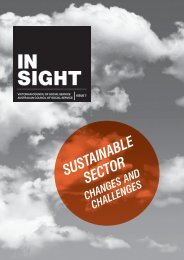Download Issue 8 (PDF) - Victorian Council of Social Service
Download Issue 8 (PDF) - Victorian Council of Social Service
Download Issue 8 (PDF) - Victorian Council of Social Service
Create successful ePaper yourself
Turn your PDF publications into a flip-book with our unique Google optimized e-Paper software.
023. CRIME AND JUSTICE<br />
INSIGHT 8<br />
We can expect imprisonment rates to continue to<br />
accelerate in Victoria under Coalition Government policies<br />
and we can expect them to have a disproportionate<br />
impact on Aboriginal people.<br />
It is not clear why changes in sentencing are specifically<br />
affecting Aboriginal people, however similar trends have<br />
been noted in other states. In New South Wales a study<br />
<strong>of</strong> the 48 per cent rise in the Aboriginal imprisonment rate<br />
from 2001–2008 found that 25 per cent <strong>of</strong> the increase<br />
was caused by more Aboriginal people being remanded in<br />
custody and for longer periods <strong>of</strong> time, and 75 per cent by<br />
more Aboriginal people being sentenced to imprisonment<br />
(rather than to a non-custodial sentencing option) and for<br />
longer periods <strong>of</strong> time. 9 None <strong>of</strong> the increase was a result <strong>of</strong><br />
more Aboriginal people being convicted <strong>of</strong> a crime. In other<br />
words, the increase in imprisonment was not caused by<br />
increases in prosecutions.<br />
We can expect imprisonment rates to continue to<br />
accelerate in Victoria under policies being pursued by the<br />
Coalition Government, and we can expect them to have a<br />
disproportionate impact on Aboriginal people. Sentencing<br />
options for the courts have been reduced with the abolition<br />
<strong>of</strong> intensive corrections orders, community-based orders,<br />
home detention and combined custody and treatment<br />
orders. Parole options have been reduced with the<br />
abolition <strong>of</strong> home detention orders which were previously<br />
available to the Adult Parole Board. Judicial discretion is<br />
being curtailed with the introduction <strong>of</strong> statutory minimum<br />
sentences <strong>of</strong> four years’ imprisonment (without parole) for<br />
new <strong>of</strong>fences related to ‘gross violence’. A new ‘community<br />
corrections order’ has been introduced which allows for a<br />
combination <strong>of</strong> imprisonment and the serving <strong>of</strong> part <strong>of</strong> the<br />
order in the community. All <strong>of</strong> these changes clearly are<br />
intended to increase the use and length <strong>of</strong> imprisonment.<br />
As the Smart Justice coalition has noted, ‘harsher<br />
sentencing will be the main driver <strong>of</strong> prison growth, not<br />
crime rates, which are falling’. 10<br />
Aboriginal Justice Agreement<br />
While this all shows the significant problem <strong>of</strong> increasing<br />
imprisonment rates in Victoria, it should also be<br />
acknowledged that the state still has an Aboriginal<br />
imprisonment rate lower than the national average and well<br />
below states like Western Australia. An important part <strong>of</strong> the<br />
explanation for this has been the <strong>Victorian</strong> Aboriginal Justice<br />
Agreement (VAJA). 11<br />
Victoria was one <strong>of</strong> the first states to establish such a<br />
justice agreement, which was the outcome <strong>of</strong> a negotiation<br />
process involving criminal justice agencies and Indigenous<br />
advisory bodies, particularly Aboriginal Justice Advisory<br />
<strong>Council</strong>s (AJACs). They attempted to address Aboriginal<br />
over-representation through establishing key principles,<br />
the identification <strong>of</strong> specific strategic areas (such as youth<br />
justice diversionary alternatives and the development <strong>of</strong><br />
non-custodial sentencing options), plus specific initiatives<br />
within each strategic area.<br />
Nationally the VAJA has been the most effective agreement<br />
in providing for ongoing Aboriginal ownership <strong>of</strong>, and<br />
participation in, strategic policy development. 12 The first<br />
VAJA emphasised the importance <strong>of</strong> ongoing Aboriginal<br />
input. This was achieved by setting up the statewide<br />
Aboriginal Justice Forum and the Regional and Local<br />
Aboriginal Justice Advisory Committees (RAJACs and<br />
LAJACs) to work alongside government agencies in<br />
progressing the VAJA. It is also only one <strong>of</strong> two national<br />
justice agreements that have been independently evaluated<br />
and found to have significantly improved justice outcomes<br />
for Aboriginal people. 13 A number <strong>of</strong> important initiatives<br />
have been developed through the Agreement including the<br />
Koori Courts.<br />
Ultimately, it is by having government and Aboriginal<br />
communities being able to work together that will<br />
make efforts to address Aboriginal over-representation<br />
successful. The <strong>Victorian</strong> AJAC (established in 1993 and<br />
now decentralised into regional and local bodies) is the<br />
only advisory committee structure still in existence in<br />
Australia from the period immediately following the Royal<br />
Commission. This process has been enhanced in Victoria<br />
through the community-based peak coordinating body<br />
established under the VAJA, the Aboriginal Justice Forum.<br />
The VAJA meets the highest standards nationally in terms<br />
<strong>of</strong> Aboriginal participation, implementation, monitoring, and<br />
independent evaluation.










